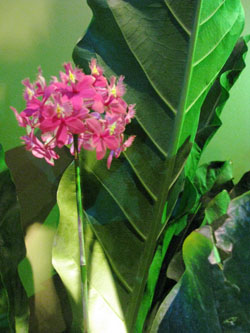“Orchids Through Darwin’s Eyes,” the Smithsonian’s 15th Annual Orchid Exhibit, brings a fresh perspective to the horticulture of the most diverse flowering plants in the world. Their beauty and boundless variations alone justify the existence of such an exhibit. But when looked at through the keen eyes of the scientists and naturalists whose research plaster the forest-green walls of the exhibit, these blooms represent something altogether more enthralling: more than 70 million years of evolutionary adaptation. 
The National Museum of Natural History is one of the few places in D.C. where the history on display isn’t man made. A sharp departure from the spectacles of government documents and presidential portraiture, entering a room filled with blossoming flowers of all shapes, sizes, and colors plays to an entirely different sensory experience.
Beyond the awe-inspiring flowers themselves, though, the exhibit details the time-tested theories of Charles Darwin. After outlining his revolutionary suppositions in 1859’s On the Origin of Species, Darwin was challenged by doubtful peers, who pushed him to conduct further research. He was happy to oblige.
The exhibit, like his 1862 book, On the Various Contrivances by which British and Foreign Orchids Are Fertilised by Insects, shows how enduring these fragrant flowers must have been to stand their ground over the years. The sexual trickery orchids—which attract mating male insects by mimicking the color, form, and even smell of their female counterparts—are treated in detail. Additionally, the exhibit teaches visitors all they could ever want to know about how asparagus and almost 200 species of vanilla plants share a fascinating historical bond with the complex Oncidium orchid.
Ten million year-old pollinia (an agglutinated mass of pollen grains) attached to the back of an extinct stinger-less bee rests preserved in amber at the center of the exhibit. It is the oldest known orchid fossil, one which illustrates the historical relationship between the flower and its pollinators. Surrounding this are small cases holding examples of what this flower and its ancestors may have looked like eons ago.
Aside from its verdant subject matter, the exhibit is decidedly “green-minded” in its physical construction. Bringing together reused components from past exhibits along with new panels and cases built with recycled and environmentally friendly material, the displays themselves reflect the progressively minded and environmentally aware atmosphere of our modern age.
Darwin’s eyes saw beauty in both flowers themselves and what they could represent scientifically. His words, on a banner drapped from the tall ceiling of the National History Museum, speak of the “grandeur in this view of life.” It’s an appropriate summation of the exhibit, for the beautiful complexities that have grown from such simple beginnings leads one to contemplate what could come next.
The National Museum of Natural History is located at Tenth Street and Constitution Avenue NW. “Orchids Through Darwin’s Eyes” will be showing through April 26, 2009.




